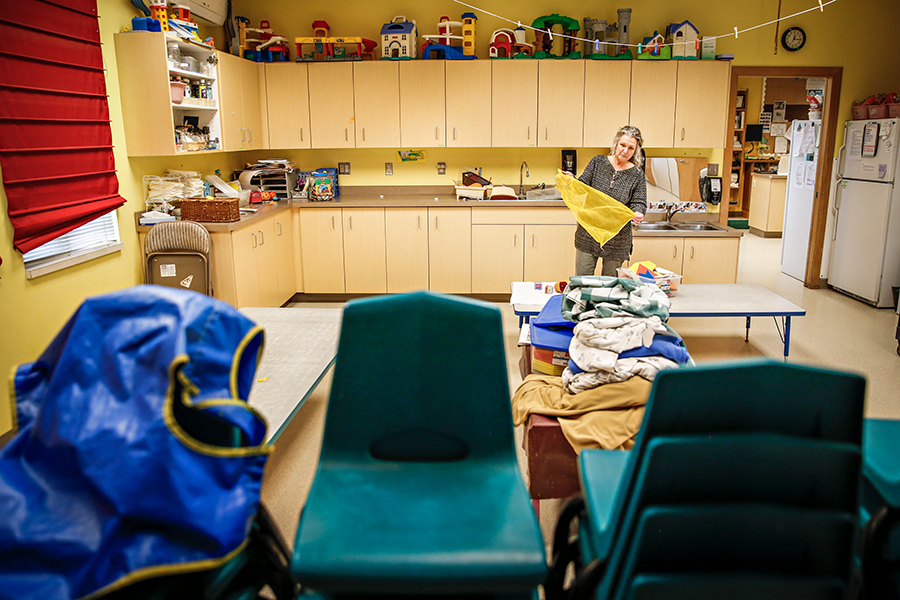Flathead Specialists Work to Find Childcare Solutions
Advocates say pandemic exacerbated already “broken” childcare system in Montana; panelists brainstormed solutions to help solve workforce shortage at July 12 chamber of commerce luncheon
By Maggie Dresser
In response to the ongoing local workforce shortage, officials at the Kalispell Chamber of Commerce, Convention and Visitor Bureau initiated conversations highlighting the role that childcare systems play within the labor force and worked to find solutions at a luncheon on July 12.
A lack of childcare has been identified as one factor in the ongoing workforce shortage, with many parents leaving the labor force to care for their kids at home, many of whom have no other option.
At Discovery Developmental Center in Kalispell, Director Collette Box says she faces multiple issues in the childcare industry, including staffing, paying a reasonable wage and keeping tuition affordable for her families. While these issues are nothing new, she says the pandemic has exacerbated them.
“The childcare system was broken before the pandemic,” Box, a panelist at the July 12 luncheon, said. “It’s always been based on families paying tuition they can’t afford and employees working for less than adequate wages so families can afford it.”
At full enrollment and staffing, Box cares for 42 kids and employs 15 people. But she’s been both under-staffed and under-enrolled since the pandemic began.
Box charges families $950 a month per child, but she can’t pay her employees much if she wants to keep her tuition manageable. While the rest of the valley competes for employees, she can’t keep up with wages that other businesses are offering.
Box’s struggle to maintain staffing means the childcare center, a nonprofit, is under-enrolled with fewer openings in a climate where there’s already a lack of childcare.
As the Flathead Valley grows, the childcare system is failing to keep up. Like the housing market, new residents are also adding pressure that will likely lead to less affordable childcare for locals.
“I’m having people move into the valley telling me my rates are too low,” Box said. “We have people buying houses with cash now and we have people willing to pay more in tuition that our local people can’t afford.”
The Nurturing Center in Kalispell offers assistance for families who struggle to pay for childcare, but Eligibility Manager Stephanie Freese says many families who can’t afford childcare still don’t qualify for the program.

Families must be at or below the federal poverty guidelines to qualify for the income-based Best Beginnings Scholarship, which means if a single parent worked 40 hours a week at $12.50 an hour, they would barely qualify. Additionally, they would still have to pay a copay of $305 a month.
“It keeps adding up and adding up,” Freese said. “If their wages are barely there or barely over it, it makes it near impossible for them to pay for it.”
Freese often sees parents turning down higher-paying jobs so they can still qualify for the program, and she also sees people reject jobs all together to stay at home because they can’t afford childcare.
Providers and employers locally and statewide have recognized the issues that the lack of childcare presents, and Whitefish-based Applied Communications consultant Kate McMahon works with communities statewide to find solutions.
In the last few years, McMahon has worked in Havre and Lewistown to conduct feasibility studies to brainstorm ways to bring a free daycare center to town.
Hospital partnerships with daycares have become common across the state and nation, and Northern Montana Health Care in Havre was willing to provide a free daycare service while potentially partnering with other large employers in town to help solve their workforce issue.
Logan Health in Kalispell has taken this approach to daycare, too, along with Print for Less in Livingston.
“It’s not just the state coming to the table, but it’s employers,” McMahon said.
But in Lewistown, McMahon says there were no employers stepping up and McMahon had to dig deeper to find strategies to address the lack of childcare.
“You really need to do a local needs assessment to understand what’s happening locally to engage the community,” McMahon said. “Everybody’s part of the solution and there are unique issues from community to community.”
Funding is also an issue, and financial spreadsheets proved that enrollment and tuition fees did not cover the operational costs.
“That was really eye opening for the community,” McMahon said.
Following the needs assessments, McMahon concluded the best options for these particular communities included expanding capacity, employer partnerships, community fundraising to help with startup costs for new childcare centers, cooperative models and starting early childcare programs at local colleges to use as a recruitment tool.
“It’s bringing all the different partners to the table and figuring out all of these different strategies,” McMahon said.
Recently, Gov. Greg Gianforte dedicated more than $38 million in American Rescue Plan Act (ARPA) funds toward increasing access to childcare, which will help for the short-term. Childcare providers hope it can at least buy some time and provide adequate wages for employees while they come up with long-term solutions.
“This money that’s coming down from the feds, it’s kind of like a shot in the arm but it’s not going to fix this system,” Box said. “But it gives us two years for the state and the feds to come together and say how do we fix something that’s been broken?”